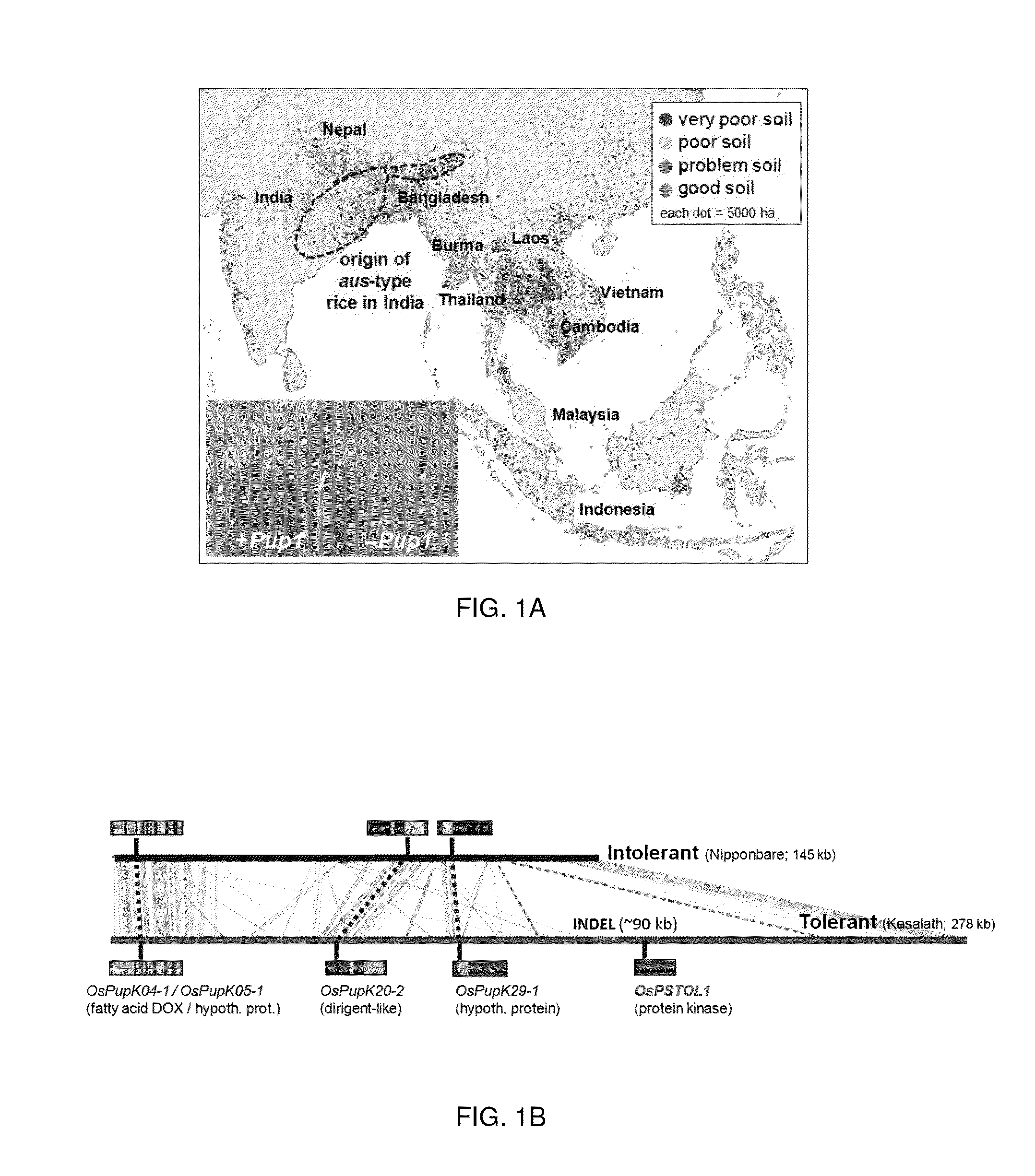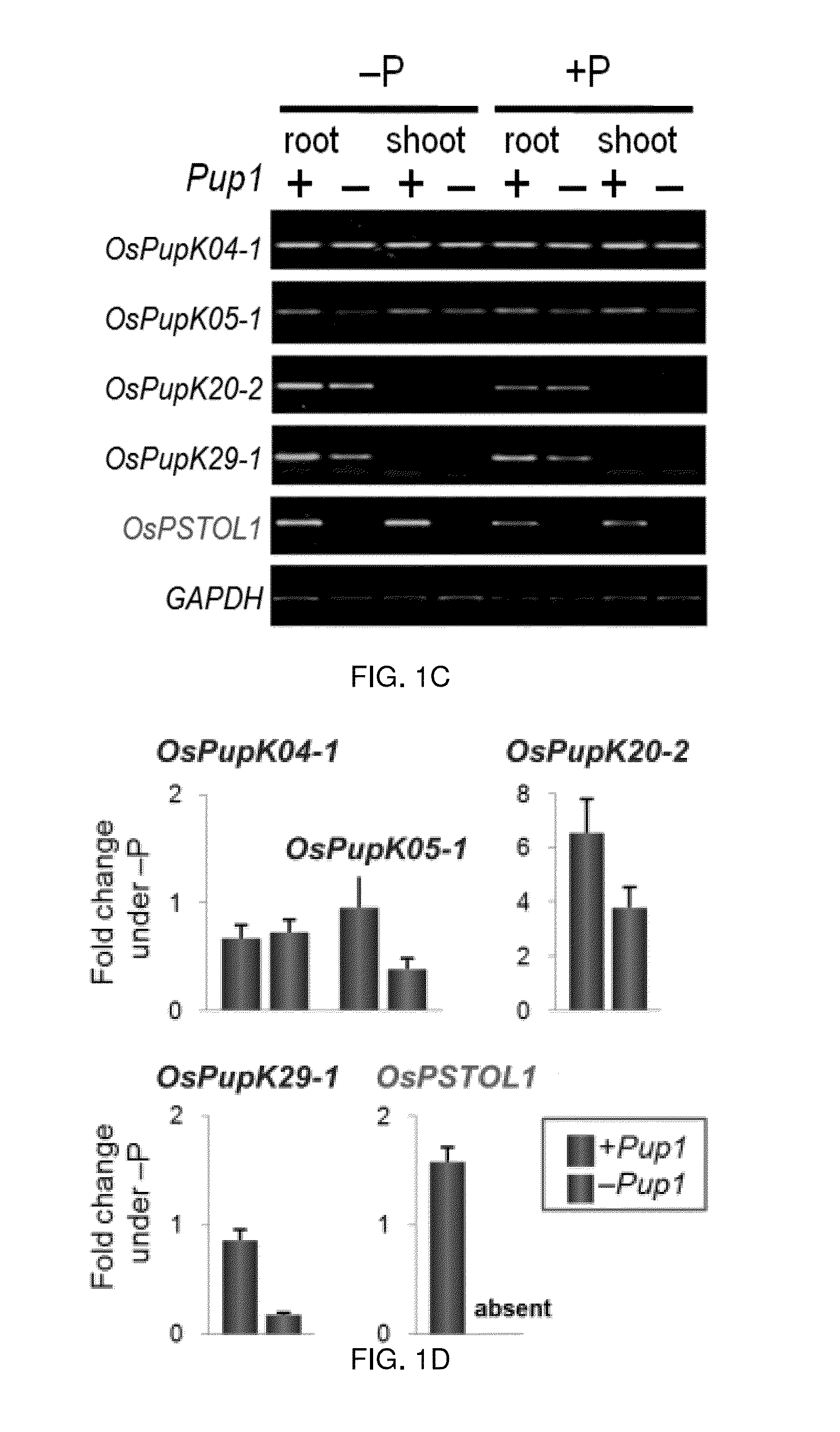Root Growth, Nutrient Uptake, and Tolerance of Phosphorus Deficiency in Plants and Related Materials and Methods
a technology of phosphorus deficiency and root growth, which is applied in the field of root growth, nutrient uptake, and tolerance of phosphorus deficiency in plants and related materials and methods, can solve the problems of low rice yield, low phosphorus (p) in soil, and low rice yield, so as to improve improve the effect of root growth and nutrient uptak
- Summary
- Abstract
- Description
- Claims
- Application Information
AI Technical Summary
Benefits of technology
Problems solved by technology
Method used
Image
Examples
example 1
Conference of Tolerance of Phosphorus Deficiency—OsPSTOL1
[0171]Quantitative RT-PCR of Pup1 candidate genes
[0172]Seeds of near isogenic lines (NILs) segregating for the Pup1 locus (+Pup1: NILs 6-4, Y-4, 14-4; Pup1: NILs Y6, Y10, and Nipponbare) (J. H. Chin et al., Theor Appl Genet, Vol. 120, pp. 1073-1086, 2010; M. Wissuwa et al., Theor Appl Genet, Vol. 105, pp. 890-897, 2002) were sown directly in pots filled with P-deficient and P-fixing Andosol from a field located at Tsukuba, Japan, that had not received P-fertilizer throughout its 40-year cropping history (−P). An equivalent of 60 kg P ha-1 was applied for the control treatment (+P). Pots were initially watered every 2-3 days and afterwards the soil was kept field capacity. The experiment was conducted in a completely randomized design with three replications and four plants per replicate pot. Root tissue samples were taken at 49 days after sowing. Total RNA was extracted using the RNeasy Mini Kit according to the instructions o...
example 2
Conference of Tolerance of Phosphorus Deficiency—OsPupK20-2
[0195]Phenotyping of OsPupK20-2 (dirigent) overexpressing lines were done for three generations. The transgenics had better grain yield compared to corresponding nulls (FIG. 12). Transgenics in all lines also showed greater panicle number and higher average tiller number (FIG. 12). Transgenic plants overexpressing OsPupK20-2 also showed enhanced root growth (FIGS. 13-15).
[0196]Dirigent overexpressors showed enhanced seedling vigor which is easily visible by large differences in plant height (FIG. 16). There was not much difference in shoot height at mature stage as compared with the large differences seen at seedling and early vegetative stage. Transgenic plants show at least 10% more fertility than their corresponding Nulls in three independent lines. The filled grain of the transgenic plant in lines 4c and 12a was more than double that of their corresponding Nulls.
[0197]Semi-quantitative RT-PCR analysis was done on OsPupk2...
example 3
[0200]A novel allele of the P-starvation tolereance gene OsPSTOL1 from African rice (Oryza glaberrima Steud) and its distribution in the genus Oryza
[0201]Plant Material
[0202]Seeds of rice varieties and wild Oryza species were obtained from IRRI, AfricaRice and JIRCAS germplasm bank. Seeds were surface sterilized with sodium hypochlorite, rinsed and incubated for 2-3 days at 30° C. The germinated seeds were then transferred to a mesh floating on Yoshida nutrient solution [containing at full strength: N 2.86 mM (as NO3NH4), P 0.05 mM, K 1 mM, Ca 1 mM, Mg 1 mM, Mn 9 μM, Mo 0.5 μM, B 18.5 μM, Cu 0.16 μM, Fe 36 μM, Zn 0.15 μM]. The nutrient solution (half-strength) was replaced weekly, until leaf samples were taken at the third week.
[0203]DNA Extraction
[0204]Small pieces of leaves tissue were flash-frozen in liquid nitrogen and kept at −80° C. until analyzed. The frozen tissue was disrupted using a Qiagen mixer mill (Retsch MM 300, Germany), and tungsten carbide beads for 1 min at 25 pu...
PUM
| Property | Measurement | Unit |
|---|---|---|
| temperature | aaaaa | aaaaa |
| temperature | aaaaa | aaaaa |
| temperature | aaaaa | aaaaa |
Abstract
Description
Claims
Application Information
 Login to View More
Login to View More - R&D
- Intellectual Property
- Life Sciences
- Materials
- Tech Scout
- Unparalleled Data Quality
- Higher Quality Content
- 60% Fewer Hallucinations
Browse by: Latest US Patents, China's latest patents, Technical Efficacy Thesaurus, Application Domain, Technology Topic, Popular Technical Reports.
© 2025 PatSnap. All rights reserved.Legal|Privacy policy|Modern Slavery Act Transparency Statement|Sitemap|About US| Contact US: help@patsnap.com



